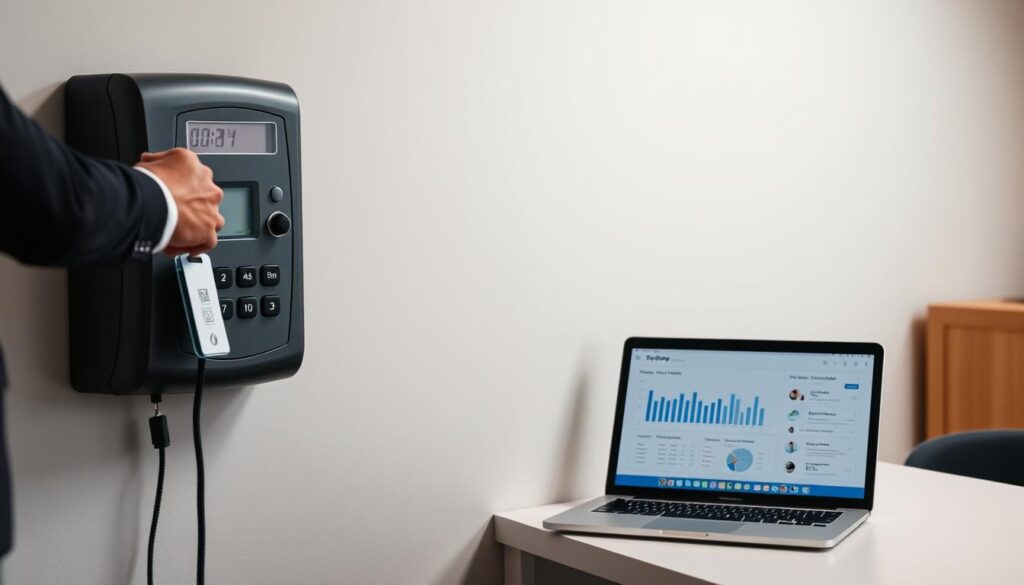Have you thought about how much your company spends on manual attendance and payroll? Many small to medium-sized enterprises (SMEs) in the Philippines think these methods save money. But, they often miss the hidden costs that can hurt productivity and finances.
Manual payroll systems are expensive, but it’s hard to see the full cost. Problems like payroll errors, compliance risks, and security issues are common. It’s important for businesses to understand these hidden costs to improve efficiency and avoid mistakes.
This article will look at the hidden effects of using old payroll methods. It will also show how automation can change things for the better.
Key Takeaways
- Manual payroll systems can lead to significant payroll errors and compliance risks.
- The average cost of data entry continues to climb, impacting overall payroll costs.
- Errors in payroll can erode employee trust, increasing turnover rates.
- Financial penalties for payroll mistakes can detract from business growth opportunities.
- Automation can significantly reduce errors and improve payroll processing efficiency.
- Regular audits and compliance checks are essential to mitigate risks associated with manual payroll processes.
The Inefficiencies of Manual Attendance Management
Manual attendance management is a big problem for small and medium businesses. It leads to errors that affect payroll. These mistakes can be costly and time-consuming.
One major issue is buddy punching, where one person clocks in for another. This increases labor costs and makes payroll harder to manage. It also hurts employee morale, as about 20% of employees face paycheck errors.
As teams get bigger, manual systems struggle to keep up. This means more time fixing mistakes. Studies show these systems can lead to 1-3% of payroll being wrong.
Businesses also face fines for not following rules because of these errors. Moving to automated systems helps avoid these problems. They offer real-time tracking and fewer errors.
The table below outlines the key differences between manual attendance management and automated systems:
| Aspect | Manual Attendance Management | Automated Attendance Management |
|---|---|---|
| Processing Time | 30% more time spent on payroll processing | 50% reduction in processing time |
| Error Rate | 1-3% of total payroll can be erroneous | Minimal errors with real-time monitoring |
| Employee Engagement | 20% report paycheck errors | Improved morale and trust in payroll accuracy |
| Compliance Issues | High risk of fines due to inaccuracies | Lower risk with accurate record-keeping |
| Staffing Needs | More HR personnel required for processing | Reduced staff needed with automation capabilities |
Switching to digital attendance management makes payroll easier. It boosts productivity and makes employees happier.
Why Manual Payroll Systems Are Costly
Manual payroll systems can cost a lot more than just labor. They often lead to 5-20% waste in payroll costs due to errors. These mistakes make managers and HR spend too much time fixing them, not on important tasks.
These old systems hurt productivity and make employees unhappy. They also make it hard to follow rules and work efficiently.

In 2023, Kroger faced four lawsuits because of wrong payroll. Over half of employers got fined for payroll mistakes in the last five years, a report found. Uber paid $100 million in taxes in 2022 because of wrong contractor labels.
“Many companies underestimate the cumulative expenses linked to outdated payroll systems, often resulting in costly mistakes and missed opportunities for growth.”
One in five payrolls has errors, costing $291 each. For a company with 1,000 workers, fixing these mistakes costs almost $1 million a year. This shows how important it is to have good payroll systems.
| Payroll Errors | Annual Costs | Implications |
|---|---|---|
| 1 in 5 payrolls contain errors | $1 million for 1,000 employees | Employee dissatisfaction and turnover |
| Average cost per payroll mistake | $291 | Decreased productivity |
| Percentage of employers penalized for non-compliance | 53% | Legal repercussions |
Switching to modern payroll systems is key for companies to grow. It helps them stay ahead in today’s fast business world.
Impact of Payroll Errors on Business Operations
Payroll errors can really hurt a business. They can lead to big mistakes in how much employees get paid. These errors make things slow and cause a lot of trouble.
A study by the American Productivity & Quality Center shows it can take 2 to 10 days to fix these problems. This can make employees unhappy because they might not get paid on time.
When employees don’t get paid right, they can get upset. This can make teams feel bad about working together. If a business messes up with overtime, it makes things worse.
Missing tax deadlines can also cause big problems. It can hurt the business’s money and make employees feel not valued. This can make people want to leave their jobs.
It’s clear that good payroll systems are important. Using technology can help avoid mistakes and make things run smoother. When employees get paid right, they feel better and work harder. Businesses need to focus on getting payroll right to keep everyone happy and working well together.
Time Theft and Buddy Punching: A Hidden Cost
Time theft, like buddy punching, is a big problem for businesses in the Philippines. Employees often add extra hours to their timesheets. This can cost companies up to 7% of their payroll, leading to big financial losses.
Studies show buddy punching costs U.S. employers about $373 million a year. It happens at 75% of businesses, with employees stealing 4.5 hours a week. This means nearly six weeks of vacation time lost each year. For companies with 1,000 employees, these losses can add up to $922,131 a year.
Payroll errors can cost a company an average of $291 per mistake. Missing or wrong time punches can cost about $78,700 for every 1,000 employees a year. These mistakes can make employees distrustful and affect the whole team’s integrity.

To fight these problems, using automated attendance systems is key. These systems can cut payroll errors by up to 60% and make time tracking more accurate. With real-time monitoring, companies can stop time theft and buddy punching. This creates a more reliable and trustworthy work place.
| Issue | Financial Impact |
|---|---|
| Buddy Punching | $373 million annually (U.S. employers) |
| Payroll Errors | $291 per error |
| Missing Time Punches | $78,700 per 1,000 employees annually |
| Time Theft Impact on Payroll | Up to 7% increase in payroll expenses |
| Percentage of Businesses Affected by Buddy Punching | 75% |
Financial Consequences of Payroll Mistakes
Payroll mistakes can cause big financial problems. A study by the IRS found that 33% of employers make these errors. This means many businesses struggle with manual processing.
On average, companies fix about 15 errors per payroll period. Each mistake costs around $291. This adds up to big financial losses, mainly for those using old systems.
For a company with 1,000 employees, fixing common mistakes takes 29 workweeks. This wastes both money and employee time. In 2023, the IRS collected billions in penalties for payroll errors. This shows how important it is to follow payroll rules.
- Failing to keep payroll records for three years can cost up to $10,000 in fines.
- Missing tax deadlines can lead to penalties and interest, increasing financial losses.
- Misclassifying workers can also cause big financial penalties.
Manual payroll systems can take 5-10 hours a week for small businesses. This is not just lost time but also means more errors. Studies show small to mid-sized businesses could face fines over one million dollars a year for not following rules.
| Payroll Mistake | Potential Cost |
|---|---|
| Average Corrections per Period | $291 |
| Time Spent Fixing Errors (1,000 employees) | 29 workweeks |
| Missed Tax Filing Penalties | Variable (uncalculated) |
| Fines for Maintaining Incomplete Records | Up to $10,000 |
| Potential Annual Fines for Non-Compliance | $1,000,000+ |
Legal costs from payroll error lawsuits can vary a lot. This makes the financial impact of these mistakes even worse. It’s important to focus on efficient payroll management to avoid these risks and save money in the long run.
Reducing Payroll Costs Through Automation
Automating payroll can greatly reduce costs for businesses. Studies show that it can cut costs by up to 80%. This makes a strong case for using advanced payroll software.
Manual payroll methods can lead to errors, from 1-8% according to the IRS. These errors can cause disputes over tax withholding and misclassify benefits. Automated solutions, on the other hand, reduce errors and improve accuracy.

Modern payroll software offers features like direct deposit and automatic calculations. This reduces processing time to just minutes. It’s great for growing businesses, as it can handle more complex payroll needs.
Automated payroll systems also offer better data security and real-time access to reports. They keep up with tax law changes. Businesses that switch to automation save on labor costs and reduce errors. It’s a key step for long-term growth.
How Manual Payroll Processes Waste Valuable Time
Manual payroll processes take up a lot of time that could be used for better things. Payroll staff spend about five hours each pay period on these tasks. This adds up to around $3,000 per year for each employee.
This time is mostly spent checking records and fixing mistakes. It means companies can’t focus on growing and improving.
Manual systems also lead to mistakes because of human error. These errors can range from 1% to 8%. For a company with 100 employees, this could mean 52 to 416 mistakes a year.
Fixing these mistakes costs between $2,600 and $20,800 annually. This shows how important it is to improve payroll accuracy and update systems.
Switching to automated payroll can greatly reduce wasted time. It also cuts down on errors and makes processing faster. Companies can look into new payroll solutions to save up to 60% of payroll time.
Managing Compliance Risks in Manual Payroll
Manual payroll systems can be risky for businesses. Mistakes in payroll can lead to big legal problems, like fines or lawsuits. These issues can cost a lot, sometimes over $20,000 a year for small businesses.

Manual payroll means spending more on labor for data entry and compliance. As companies grow, nearly 70% struggle with manual payroll. This can lead to errors and non-compliance risks.
- About 40% of small businesses face fines and penalties for payroll errors.
- Human mistakes in manual payroll can lead to high costs, up to $100,000 in lawsuits.
- Companies that wrongly classify employees can face penalties of $1,000 to $10,000 per worker.
Switching to automated payroll systems can lower risks. Modern payroll software can cut human error by 80%. Outsourcing payroll can also reduce risks by 50%, thanks to experts in laws.
Choosing the right payroll system helps businesses grow without worrying about compliance. Good payroll management boosts employee morale and productivity. It keeps a company’s finances safe and improves its reputation.
Boosting Employee Trust Through Accurate Payroll
Accurate payroll is key to building trust and keeping employees. Mistakes in payroll can lead to big penalties and legal issues. A reliable system makes a workplace transparent and accountable, boosting loyalty.
Streamlining payroll can make employees trust and happy by 25%. Getting paid correctly boosts morale. Automating payroll cuts errors by 80% and speeds up processing by 30%.
Regular payroll audits help catch mistakes early. This can prevent big problems. Using integrated solutions can improve retention by 50%.
Automated systems save money and reduce risks. They can save up to $10,000 a year. Accurate payroll shows employees they’re valued, creating a better work place.
For more on payroll tracking, check out this guide.
Implementing Payroll Software for Accuracy
Using payroll software can make payroll more accurate and easier to manage. It cuts down on mistakes made by humans. This means employees get paid on time and correctly. Tools like Vorecol HRMS make complex payroll tasks simple and report generation easy.
Starting to use automated payroll might cost a lot at first. But, it can save money in the long run. It makes payroll work much faster, taking just hours instead of days. This lets businesses focus more on their main work, not just paperwork.
Automated systems also help with tax rules. They help avoid mistakes in tax calculations and filings. Plus, they keep payroll data safe with strong security features like encryption and cloud backups.
Payroll software also lets employees check their pay online. This makes them happier and more informed about their pay. It’s a big win for both employees and employers.
| Benefit | Manual Processing | Automated Payroll Software |
|---|---|---|
| Time Required | Up to 3 days for processing | Just a few hours |
| Error Rate | High due to human involvement | Significantly lower |
| Compliance | Risk of penalties and legal issues | Enhanced with automated updates |
| Data Security | Physical storage risks | Encryption and cloud backups |
| Employee Access | Limited information availability | Online access to paycheck information |
Choosing payroll software makes payroll work better and faster. It’s a smart move that saves money and reduces risks. It’s a big step towards making payroll work more efficient and accurate.
Conclusion
Manual payroll processing comes with hidden costs, mainly for small and medium businesses in the Philippines. As the market gets more competitive, moving to automated payroll systems is now essential. Manual methods can lead to many errors, which cost a lot to fix and can break rules.
These errors can lead to fines of $500 to $7,500 per mistake. This can really hurt a company’s finances.
Manual payroll takes about 5 hours per pay period, which cuts into productivity. The yearly cost of manual payroll is over $3,000. Automated systems offer big benefits like fewer errors and faster work.
Companies using automated systems can work 50% faster than those doing it manually. This helps businesses grow and succeed.
Choosing payroll automation makes work more accurate, follows rules better, and builds trust with employees. As work gets more complex, using advanced payroll solutions is key for lasting growth. It helps avoid big costs that old ways often ignore.
